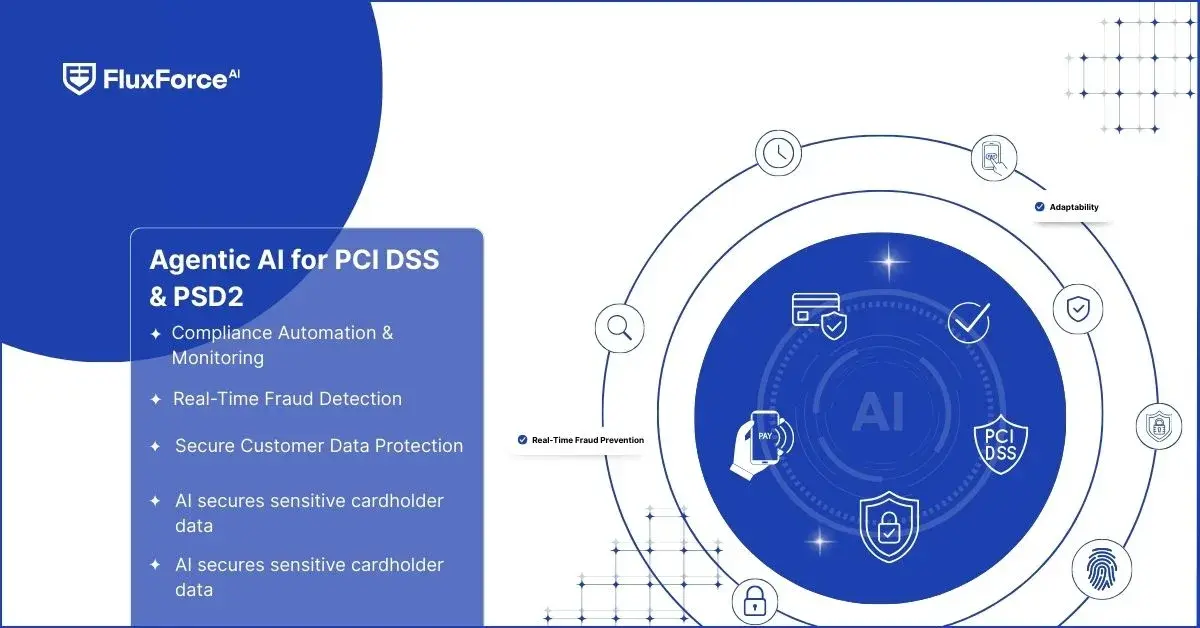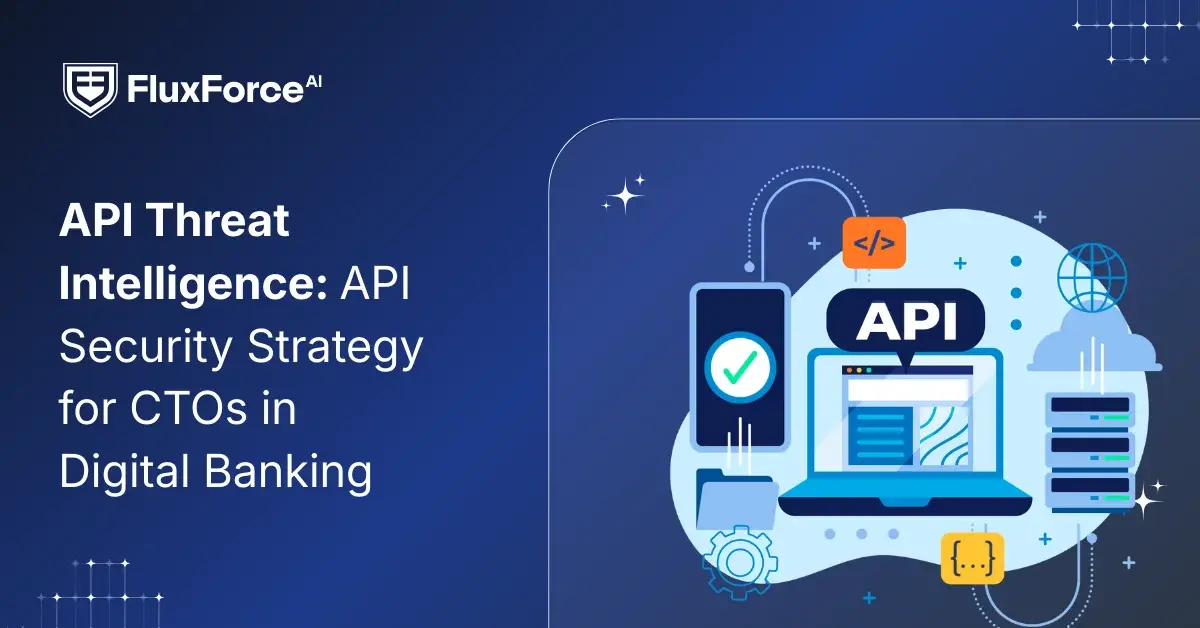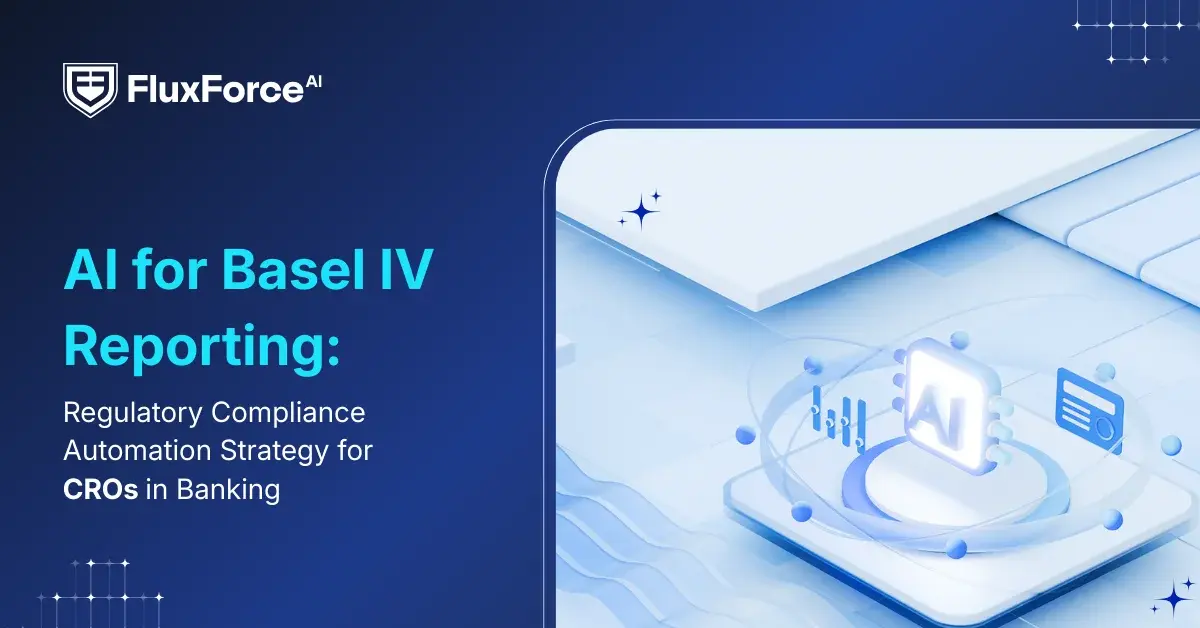Listen To Our Podcast🎧

Introduction
Financial institutions are facing a paradox: as digital payments increase, so do the complexities of maintaining compliance with standards like PCI DSS and PSD2. A significant concern is the rising sophistication of fraud attempts. According to Deloitte's 2024 financial services report, generative AI could enable fraud losses to reach $40 billion in the U.S. by 2027, up from $12.3 billion in 2023, highlighting the urgent need for advanced security measures.
This raises a pressing question for compliance leaders: can institutions enforce PCI DSS and PSD2 standards continuously without overloading internal teams?
The answer lies in Agentic AI payment security. By operating autonomously, Agentic AI in financial compliance monitors transactions, flags anomalies, and enforces rules in real time, removing the bottlenecks of human oversight.
With AI-driven payment compliance, banks gain the ability to:
- Maintain PCI DSS compliance AI that adapts dynamically to emerging threats.
- Implement PSD2 security with AI to monitor transaction authenticity across channels.
- Free compliance teams to focus on strategic risk management rather than repetitive audits.
Early adopters report that integrating Agentic AI payment security not only strengthens compliance but also builds customer trust. Machine learning models embedded in AI-powered PCI DSS solutions can identify subtle patterns that human auditors might miss.
In a world where payment systems are under constant attack, the shift to autonomous, intelligent compliance become a necessity. Financial institutions leveraging Agentic AI in financial compliance position themselves to detect threats before they escalate, maintain regulatory integrity, and protect sensitive payment data with precision.
How AI is Changing PCI DSS Compliance

Why Traditional PCI DSS Audits struggle
Many banks and fintechs find it hard to keep up with PCI DSS rules. Manual audits are slow and can miss small but important problems, especially when transactions happen at high speed. Compliance gaps are a main reason for payment data breaches, and this raises a key question for compliance teams that: How can organizations stay compliant without slowing down operations?
Let’s find that out.
How AI makes Compliance smarter
AI-powered PCI DSS solutions handle the hard work of auditing and monitoring automatically. They can check payment systems, review encryption and access controls, and spot unusual activity. With PCI DSS compliance AI, companies can catch issues as they happen instead of fixing them after the fact.
Monitoring Payments all the time
For a company handling millions of payments each day, manual checks leave gaps that fraudsters can exploit. Continuous verification for PCI DSS means AI watches every transaction, system change, and user access. PCI compliance monitoring becomes active all the time, helping prevent problems before they happen.
Making Audits faster and easier
Auditors no longer have to go through logs and settings manually. PCI compliance audit software powered by AI can make reports, highlight risks, and suggest fixes. Using AI automation for PCI DSS audits speeds up audits and reduces mistakes, letting teams focus on strategy and risk planning.
Banks using AI-powered PCI DSS solutions report faster audits, fewer compliance mistakes, and stronger data protection. PCI software compliance works smoothly, and PCI DSS compliance solutions can adjust to new rules quickly, keeping both institutions and customers safer.
PSD2 Security with Agentic AI for Real-Time Payment Protection
Integrating PSD2 Compliance into daily operations
Once PCI DSS compliance is automated, banks face PSD2’s additional requirements: real-time authentication, secure third-party access, and consent tracking. In operations teams, this often means managing hundreds of thousands of transactions per day, each needing dynamic risk assessment. Agentic AI in financial compliance allows institutions to embed compliance checks directly into transaction workflows, so approvals, risk scoring, and alerts happen without manual intervention.
Real-Time Risk Scoring and Authentication
AI continuously evaluates transaction data against behavioral and contextual patterns. For example, if a corporate client initiates a high-value transfer from a new IP address during off-hours, the AI engine can require additional authentication in real time. Low-risk transactions continue without delay. This operationalizes PSD2 security with AI across every payment channel, reducing manual review bottlenecks while maintaining compliance.
Securing Open Banking Integrations
Open banking APIs expose sensitive account data to third-party providers. Banks must ensure each API call follows PSD2 rules. AI monitors API traffic patterns, flags unusual request sequences, and prevents unauthorized access. By integrating secure payment orchestration AI into API gateways, operations teams maintain continuous verification and regulatory alignment without adding overhead.
Automated Consent Management
PSD2 requires tracking customer consent for data sharing. Agentic AI ensures every consent record is up-to-date, enforceable, and auditable. In practice, AI can prevent a third-party provider from accessing data if consent has expired or is missing, while automatically logging all approvals for internal compliance reviews. AI regulatory compliance tools make this process operational rather than a manual audit task.
Practical Operational Impact
Banks using PSD2 compliance automation have reduced false positives in fraud alerts, cut transaction delays, and improved regulatory reporting. Operations teams can now focus on handling exceptions, policy updates, and high-risk investigations, rather than repetitive monitoring. By combining fraud detection AI in PSD2 compliance with existing PCI DSS frameworks, institutions achieve end-to-end payment security, from cardholder data protection to real-time transaction integrity.
Protecting Payment Data with AI-Enabled Tokenization

Why Traditional Data Protection fails in High-Volume Transactions
Banks process millions of payments daily and storing raw cardholder data increases breach risk. Manual checks or static encryption often fail to catch anomalies in real time. Institutions face the challenge of securing sensitive data without slowing transactions.
How AI-Powered Tokenization solves this
AI-powered PCI DSS solutions dynamically replace sensitive data with tokens during each transaction. PCI DSS tokenization AI solutions automatically map tokens to transaction records, reducing exposure and keeping payment flows smooth.
Detecting Anomalies before Fraud escalates
AI continuously monitors tokenized data for unusual activity. Using AI in regulatory compliance for payments, suspicious patterns trigger alerts immediately. This allows operational teams to act before breaches or fraudulent transactions impact customers.
Securing APIs and Third-Party Integrations
Open banking APIs create new exposure points. Secure payment orchestration AI enforces encryption and access rules, ensuring tokenized data remains protected across internal systems and third-party endpoints.
What Compliance teams gain
- Reduced manual oversight of sensitive data
- Faster reporting for regulators
- Ability to focus on high-risk investigations instead of routine monitoring
AI-driven payment compliance strengthens operational security, keeps PCI DSS and PSD2 aligned, and ensures institutions are proactive rather than reactive.
Onboard Customers in Seconds

Business and Operational Impact of Agentic AI in Payment Compliance
Financial institutions are under constant pressure to balance security, compliance, and customer experience. Manual compliance processes often create bottlenecks, while outdated fraud detection tools leave gaps. Integrating Agentic AI payment security changes this balance by making compliance continuous and predictive.
Stronger Compliance Without Heavy Workloads
By adopting AI-powered PCI DSS solutions and PSD2 compliance automation, banks can maintain regulatory alignment in real time. Instead of periodic audits, AI provides continuous checks, reducing the burden on compliance teams and cutting down on errors.
Lower Fraud and Operational Costs
Institutions using AI regulatory compliance tools report measurable reductions in fraud losses. Predictive analytics prevent fraud before it escalates, which lowers operational costs linked to chargebacks, disputes, and investigations.
Faster Audit Readiness and Reporting
PCI DSS compliance audit software powered by AI generates detailed reports automatically. This improves readiness for regulators and saves weeks of preparation time, which is a major advantage in audit-heavy sectors like banking and fintech.
Building Trust with Customers and Regulators
When fraud is detected early and payment data is consistently protected, customers feel more confident using digital payment channels. Regulators also view institutions that use AI-driven payment compliance as stronger, reducing scrutiny and penalties.
Long-Term Competitive Advantage
- More efficient compliance operations
- Lower risk of penalties or fines
- Improved customer trust and retention
- Scalable security that grows with transaction volumes
Agentic AI positions financial institutions to stay compliant, protect customer data, and improve efficiency at the same time. Instead of treating compliance as a burden, banks can turn it into a strategic advantage.
Conclusion
Manual audits and rule-based fraud checks cannot keep pace with rising threats. With fraud losses climbing and PCI DSS and PSD2 rules evolving, financial institutions need compliance that operates in real time. Agentic AI in financial compliance provides continuous monitoring, predictive fraud detection, and automated reporting that keep both regulators and customers confident.
For banks and fintechs, adopting AI-driven payment compliance is more than meeting requirements. It reduces risks, lowers costs, and turns compliance into a competitive advantage.






Share this article